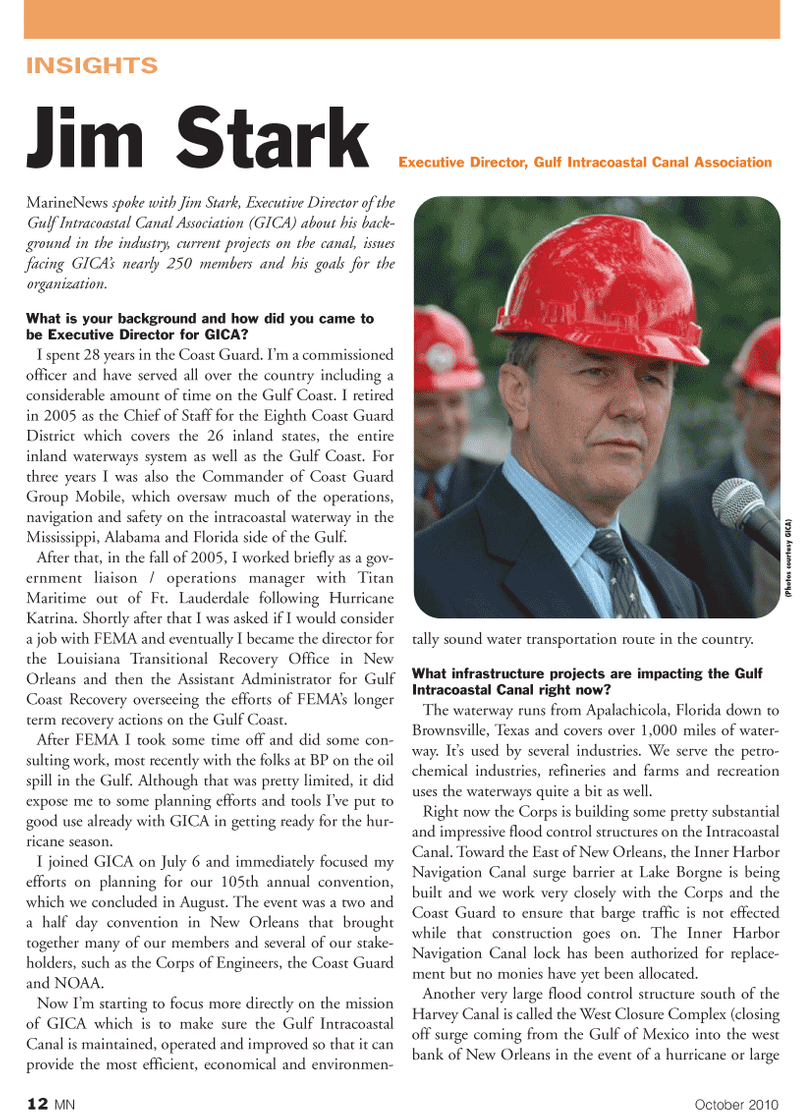
Page 12: of Marine News Magazine (October 2010)
Annual World Yearbook
Read this page in Pdf, Flash or Html5 edition of October 2010 Marine News Magazine
12 MN October 2010
MarineNews spoke with Jim Stark, Executive Director of the
Gulf Intracoastal Canal Association (GICA) about his back- ground in the industry, current projects on the canal, issues facing GICA’s nearly 250 members and his goals for the organization.
What is your background and how did you came to be Executive Director for GICA?
I spent 28 years in the Coast Guard. I’m a commissioned officer and have served all over the country including a considerable amount of time on the Gulf Coast. I retired in 2005 as the Chief of Staff for the Eighth Coast Guard
District which covers the 26 inland states, the entire inland waterways system as well as the Gulf Coast. For three years I was also the Commander of Coast Guard
Group Mobile, which oversaw much of the operations, navigation and safety on the intracoastal waterway in the
Mississippi, Alabama and Florida side of the Gulf.
After that, in the fall of 2005, I worked briefly as a gov- ernment liaison / operations manager with Titan
Maritime out of Ft. Lauderdale following Hurricane
Katrina. Shortly after that I was asked if I would consider a job with FEMA and eventually I became the director for the Louisiana Transitional Recovery Office in New
Orleans and then the Assistant Administrator for Gulf
Coast Recovery overseeing the efforts of FEMA’s longer term recovery actions on the Gulf Coast.
After FEMA I took some time off and did some con- sulting work, most recently with the folks at BP on the oil spill in the Gulf. Although that was pretty limited, it did expose me to some planning efforts and tools I’ve put to good use already with GICA in getting ready for the hur- ricane season.
I joined GICA on July 6 and immediately focused my efforts on planning for our 105th annual convention, which we concluded in August. The event was a two and a half day convention in New Orleans that brought together many of our members and several of our stake- holders, such as the Corps of Engineers, the Coast Guard and NOAA.
Now I’m starting to focus more directly on the mission of GICA which is to make sure the Gulf Intracoastal
Canal is maintained, operated and improved so that it can provide the most efficient, economical and environmen- tally sound water transportation route in the country.
What infrastructure projects are impacting the Gulf
Intracoastal Canal right now?
The waterway runs from Apalachicola, Florida down to
Brownsville, Texas and covers over 1,000 miles of water- way. It’s used by several industries. We serve the petro- chemical industries, refineries and farms and recreation uses the waterways quite a bit as well.
Right now the Corps is building some pretty substantial and impressive flood control structures on the Intracoastal
Canal. Toward the East of New Orleans, the Inner Harbor
Navigation Canal surge barrier at Lake Borgne is being built and we work very closely with the Corps and the
Coast Guard to ensure that barge traffic is not effected while that construction goes on. The Inner Harbor
Navigation Canal lock has been authorized for replace- ment but no monies have yet been allocated.
Another very large flood control structure south of the
Harvey Canal is called the West Closure Complex (closing off surge coming from the Gulf of Mexico into the west bank of New Orleans in the event of a hurricane or large
Jim Stark Executive Director, Gulf Intracoastal Canal Association
INSIGHTS (Photos courtesy GICA)

 11
11

 13
13
